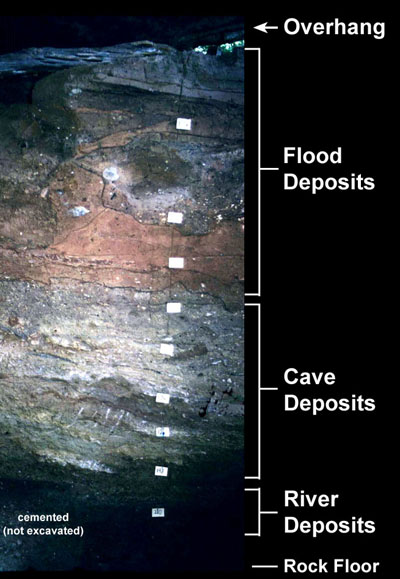|
Cave deposits. A period with no apparent floodwaters entering the shelter, and a thick stratum of cave deposit accumulated. The Cave deposits (Stratum 5) contained more human occupational debris, increasing in density toward the top. A possible unfluted Clovis point and two Folsom points were found in Sub-Stratum 5A. Above that layer was a thin but heavily occupied stratum in which no diagnostic materials were found (Sub-Stratum 5B).
Sub-Stratum 5C contained no diagnostics although remains of a fire hearth and animal bones were uncovered. Sub-Stratum 5D also contained a quantity of tiny animal bones as well as bison bone, along with chipped-stone and bone tools. Sub-Stratum 5E was largely cemented and contained only scant cultural remains and no diagnostic materials. Sub-Stratum 5F held more evidence of occupations, including Brazos Fishtail (a likely variant of San Patrice), Wilson, hearths, and animal bone. Above this was a dark gray stratum (Sub-Stratum 5G) reflecting intense occupation. Numerous hearths, Brazos Fishtail and Wilson dart points, large quantities of unifacial tools, and animal bone were recovered. From this stratum, and buried at the time, came a multiple human burial along a variety of grave items.
Transitional and Outer Deposits
Stratum 6 was a mix of cave deposits and river sand. Here were found Scottsbluff, a possible Wilson point, tools, and food remains.
Stratum 7, located to the front and outside of the shelter proper (or dripline), was largely a mix of rock fall and colluvial deposits washing over the top of the shelter and river clays. This deep, complex deposit was likely contemporaneous to the various cave deposits it abutted, but it has not been directly correlated. A Clovis-age hearth and extinct bison bones were uncovered at its lowest level, overlying Stratum 3, and Brazos Fishtail, possible Wilson, and other stemmed points were found at slightly higher levels with Stratum 7.
Flood deposits. These are distinguished from the earlier River deposits by less coarse materials. During this time, periodic flooding occurred and at times the shelter was completely filled. Thin layers of red alluvial sands were deposited above the Cave deposits (see Stratum 8 and its multiple sub-strata). During this time, people who made unfluted lanceolate dart points occupied the shelter. Following those occupations, more flooding occurred, and the red sands were capped with a circa 12-inch stratum of culturally sterile yellow clay, Stratum 9. At that point the shelter was almost entirely filled.
Eventually, the yellow clay and part of the red "Plainview" sands were washed out, as evidenced by truncation of these deposits, especially of the yellow clay. After this time, Archaic people began occupying the shelter (see Stratum 10 and Stratum 11 ). A variety of dart points were recovered from these layers, but none diagnostic of the Early Archaic. Archaic occupations continued until a flood or floods filled the shelter, depositing some 30-36 inches of sand and effectively sealing the overhang.
Sometime, likely in the late nineteenth or early twentieth century, a portion of the south end of the shelter was cleared out and occupied by campers who used it as a dwelling. Whether the clearing was accomplished by digging or erosion is not clear; it could have been a combination of both. These "Historic Period" occupations are described in the section Strata 12-14. After this, relic collectors removed a larger area of the south half of the shelter, destroying up to 7 vertical feet of Archaic and Late Prehistoric archeological deposits. |
